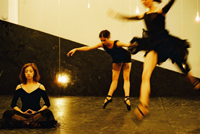Improvisation is radical.
It takes risk to fail. Risk places the audience in a place of immediacy with the performer. It gives the performer agency over the choreography. It can take a completely unexpected turn that falls outside of the original plan. Risk is synonymous with improvisation and is, therefore, unrepeatable – much more so than set, phrased, rehearsed choreography.
I feel that in an era of mass digitization and repeatability through media, that failure, roughness, the messiness of a live body and a focus on identity of that body are also radical states.
Improvisation is also immediate and communicative. Because we so often work in participatory contexts, improvisation is powerful in that it can be shared with any body in any location – not just a theatre and not just with other dancers. Whether the language is hip hop, pow wow, butoh or contemporary, improvisation is what I find to be vital, democratic and provocative in dance.
I have danced since childhood, funnelled through the Royal Academy of Dance machine before landing at Simon Fraser University’s dance program in 1989. At that time, Iris Garland was teaching improvisation, and her kooky, open-instruction explorations took me to a level of freedom and awareness that I had never imagined before. I soon connected with Ruth Emerson, one of the original Judson Church members, who schooled me on the New York sixties postmodernism in dance and community-focused work. Later, my time spent with EDAM observing and participating in the Forced Issues shows of long-format improvisation with the full company and live band sealed the deal. I found improvisation to be the most vital and immediate form of dance that I could practise. It reminded me of the ease and constant groove-play of club dancing but could still possess structure and control and be decidedly in or out of sync with the music, the voice, other dancers and viewers. I remain a lifelong devotee to the form. When I lived in Japan for four years, I danced no set choreography and was lucky to experience improvisation as the cultural norm.
Now, I work to expand improvisational methods as well as the notions of what is dance and who can be a dancer, looking for dance that lives in the moment that is shared. I encourage dancers everywhere to spend less time perfecting choreography in front of mirrors and more time immersing themselves in the moment of movement, and with others.
~
This article was originally published in the May/June 2018 twentieth anniversary issue as part of the anniversary feature “Provocations”
A little goes a long way. Donate to The Dance Current today to support bold and inclusive coverage of dance in Canada.
Tagged: Contemporary, improvisation, Provocations, All





